Bishop of Salisbury
| Bishop of Salisbury | |
|---|---|
| Bishopric | |
| anglican | |
|
Incumbent: Nick Holtam | |
| Province | Canterbury |
| Diocese | Salisbury |
| Cathedral | Salisbury Cathedral |
| First incumbent |
Aldhelm Herman (first bishop at Sarum) |
| Formation |
709 1075 (translated to Salisbury) |
The Bishop of Salisbury is the ordinary of the Church of England's Diocese of Salisbury in the Province of Canterbury. The diocese covers much of the counties of Wiltshire and Dorset. The see is in the City of Salisbury where the bishop's seat is located at the Cathedral Church of the Blessed Virgin Mary. The current bishop is Nick Holtam,[1][2] the 78th Bishop of Salisbury, who was consecrated at St Paul's Cathedral on 22 July 2011 and enthroned in Salisbury Cathedral on 15 October 2011.[3][4]
History
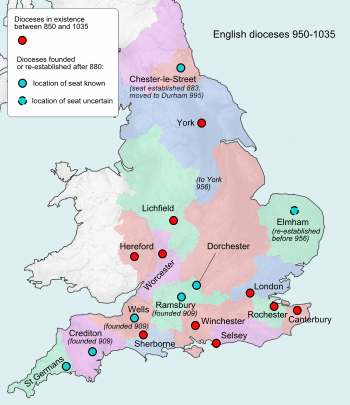
The Diocese of Sherborne (founded c. AD 705) was the origin of the present diocese; St Aldhelm was its first bishop. Ramsbury's diocese was created from the northwestern territory of the bishop of Winchester in 909.[5]
The Anglo-Saxon Diocese of Sherborne was established by Saint Aldhelm in about 705 and comprised the counties of Devon, Somerset, Dorset, and Cornwall. The diocese lost territory on the creation of the bishopric of Cornwall in the early 9th century, and lost further territory on the creation of the bishoprics of Wells and Crediton by Plegmund, Archbishop of Canterbury in 909.
In 1058, the Sherborne chapter elected Herman of Ramsbury as their own bishop. He had previously complained of the poverty of his diocese to the extent that, when his plan to become abbot of Malmesbury was blocked by Earl Godwin in 1055, he had abandoned his duties and left to become a monk at St Bertin in France. Following the Norman conquest, the 1075 Council of London united his two sees as a single diocese and translated them to the then-larger settlement around the royal castle at Salisbury (Old Sarum). With papal approval, this was later removed to New Sarum (modern Salisbury) in the 1220s.
Herman of Wilton, bishop of both Ramsbury and then Sherborne,[5] obtained approval from Edward the Confessor to transfer his seat to Malmesbury, but this plan was blocked by local monks and Earl Godwin.[6] Instead, following the Norman conquest, the 1075 Council of London named him bishop of Sarisberie[7] (Latin: Seriberiensis episcopus[8]), which had been made a royal stronghold by William I. This was at Old Sarum. Disputes between Bishops Herbert and Richard Poore and the sheriffs of Wiltshire led to the removal of the see in the 1220s to a new site in the plain. This was chartered as the city of New Sarum by King Henry III in 1227,[9] but it wasn't until the 14th century that the office was described (by Bishop Wyvil) as the bishop of Sarum (episcopus Sarum).[10] The diocese, like the city it administers, is now known as Salisbury. The archdeaconry around Salisbury, however, retains the name of Sarum.
Reforms within the Church of England led to the annexation of Dorset from the abolished diocese of Bristol in 1836; Berkshire, however, was removed the same year and given to Oxford. In 1925 and 1974, new suffragan bishops were appointed to assist the Bishop of Salisbury; the new offices were titled the bishops of Sherborne and Ramsbury, respectively.[5] Until 2009[11] the bishops operated under an episcopal area scheme established in 1981, with each suffragan bishop having a formal geographical area of responsibility, and being known as "area bishops". The Bishop of Ramsbury had oversight of the diocese's parishes in Wiltshire, while the Bishop of Sherborne had oversight of the diocese's parishes in Dorset. This scheme was replaced to reflect the increased working across the whole diocese by all three bishops. The two suffragans may now legally function anywhere in the diocese, and the Bishop of Salisbury may delegate any of his functions to them.
List of bishops
| Bishops of Sherborne | |||
|---|---|---|---|
| From | Until | Incumbent | Notes |
| c. 705 | 709 | Saint Aldhelm | Also Abbot of Malmesbury. |
| 709 | 737? | Forthhere | Also recorded as Fordhere. Possibly resigned the see in 737. |
| 736 | 766 x 774 | Herewald | |
| 766 x 774 | 789 x 794 | Æthelmod | |
| 793 | 796 x 801 | Denefrith | |
| 793 x 801 | 816 x 825 | Wigberht | Also recorded as Wigheorht. |
| 816 x 825 | 867 | Eahlstan | Also recorded as Alfstan. |
| 867 or 868 | 871 | Saint Heahmund | Also recorded as Saint Hamund. |
| 871 x 877 | 879 x 889 | Æthelheah | |
| 879 x 889 | 890 x 900 | Wulfsige I | |
| 890 x 900 | 909 | Asser | Also recorded as John Asser or Asserius Menevensis. |
| c. 909 | c. 909 | Æthelweard | |
| c. 909 | 918, or 909 x 925 | Wærstan | |
| 918, or 909 x 925 | 918, or 909 x 925 | Æthelbald | |
| 918, or 909 x 925 | 932 x 934 | Sigehelm | |
| 932 x 934 | 939 x 943 | Alfred | |
| 939 x 943 | 958 x 964 | Wulfsige II | |
| 958 x 964 | 978 | Ælfwold I | |
| 978 or 979 | 991 x 993 | Æthelsige I | |
| 993? | 1002 | Wulfsige III | Died in office on 8 January 1002. |
| 1002 | 1011 or 1012 | Æthelric | |
| 1011 or 1012 | c. 1014 | Æthelsige II | |
| 1014 x 1017 | 1014 x 1017 | Brithwine I | |
| 1017 | 1023 | Ælfmaer | Abbot of St Augustine's Abbey, Canterbury. Died in office, possibly on 5 April 1023. |
| 1023 | 1045 | Brihtwine II | Died in office, possibly on 2 June 1045. |
| 1045 | 1058 | Saint Ælfwold II | Venerated as a saint with his Feast day on 25 March. |
| 1058 | 1075 | Herman | Also Bishop of Ramsbury. Became the first Bishop of Salisbury when the sees of Sherborne and Ramsbury were transferred to Salisbury (Old Sarum) in 1075. |
| Source(s): [12][13] | |||
Pre-Reformation
| Bishops of Salisbury | |||
|---|---|---|---|
| From | Until | Incumbent | Notes |
| See at Old Sarum | |||
| 1075 | 1078 | Herman | Bishop of Sherborne (1058–75) and of Ramsbury (1045–55 and 1058–75). Removed the two sees to Salisbury (Old Sarum) in 1075. Died in office. |
| 1078 | 1099 | Saint Osmund | Died in office. Canonized by Pope Callixtus III in 1457. |
| 1099 | 1102 | See vacant | |
| 1102 | 1139 | Roger of Salisbury | Formerly Lord Chancellor. Died in office. |
| 1140 | Henry de Sully | Nominated by Henry of Blois, but was rejected by King Stephen. In compensation, Sully became abbot of Fécamp Abbey. | |
| 1140 | 1141 | Philip de Harcourt | Dean of Lincoln. Nominated by King Stephen, but Henry of Blois refused to consecrate. Harcourt appealed to Rome, but the nomination was quashed. Later became Bishop of Bayeux. |
| 1142 | 1184 | Josceline de Bohon | Also recorded as Jocelin Bohon. Formerly Archdeacon of Winchester. Resigned in 1184 and became a Cistercian monk at Forde Abbey, Dorset. |
| 1184 | 1189 | See vacant | |
| 1189 | 1193 | Hubert Walter | Formerly Dean of York. Translated to Canterbury |
| 1194 | 1217 | Herbert Poore | Formerly Archdeacon of Canterbury. Translated to Canterbury. |
| 1217 | 1225 | Richard Poore | Previously Dean of Salisbury (1197–1215) and translated from Chichester. Removed see to Salisbury. |
| See at Salisbury | |||
| 1225 | 1228 | Richard Poore (cont.) | Removed the see from Old Sarum. Translated to Durham. |
| 1229 | 1246 | Robert de Bingham | Also recorded as Robert Bingham. Died in office. |
| 1246 | 1256 | William de York | Formerly Provost of Beverley. Died in office. |
| 1256 | 1262 | Giles of Bridport | Formerly Dean of Wells. Died in office. |
| 1263 | 1271 | Walter de la Wyle | Formerly Sub-chanter of Salisbury. Died in office. |
| 1271 | 1284 | Robert Wickhampton | Formerly Dean of Salisbury. Died in office. |
| 1284 | 1286 | Walter Scammel | Formerly Dean of Salisbury. Died in office. |
| 1287 | 1288 | Henry Brandeston | Formerly Dean of Salisbury. Died in office. |
| 1288 | Lawrence de Awkeburne | Elected but died before consecration. | |
| 1288 | 1291 | William de la Corner | Formerly Archdeacon of Northumberland. Died in office. |
| 1291 | 1297 | Nicholas Longespee | Formerly a Prebendary of Salisbury. Died in office. |
| 1297 | 1315 | Simon of Ghent | Died in office. |
| 1315 | 1330 | Roger Martival | Formerly Dean of Lincoln. Died in office. |
| 1330 | 1375 | Robert Wyvil | Also recorded as Robert Wyville. Died in office. |
| 1375 | 1388 | Ralph Ergham | Translated to Bath & Wells. |
| 1388 | 1395 | John Waltham | Also Master of the Rolls and Lord Treasurer. Died in office. |
| 1395 | 1407 | Richard Mitford | Translated from Chichester. Died in office. |
| 1407 | Nicholas Bubwith | Also recorded as Nicholas Bubbewith. Translated from London. Afterwards translated to Bath & Wells. | |
| 1407 | 1417 | Robert Hallam | Formerly Archdeacon of Canterbury and Chancellor of Oxford. Created a pseudocardinal by Antipope John XXIII in 1411, but Hallam did not accept the promotion. Died in office. |
| 1417 | 1426 | John Chandler | Also recorded as John Chaundler. Formerly Dean of Salisbury. Died in office. |
| 1427 | 1438 | Robert Neville | Also recorded as Robert Nevill. Formerly Provost of Beverley. Translated to Durham. |
| 1438 | 1450 | William Ayscough | Also recorded as William Aiscough. Murdered by an angry mob during Jack Cade’s rebellion. |
| 1450 | 1481 | Richard Beauchamp | Translated from Hereford. Died in office. |
| 1482 | 1484 | Lionel Woodville | Formerly Dean of Exeter and Chancellor of Oxford. Died in office. |
| 1485 | 1493 | Thomas Langton | Translated from St David's. Afterwards translated to Winchester. |
| 1493 | 1499 | John Blyth | Also recorded as John Blythe. Also Master of the Rolls and Chancellor of Cambridge. Died in office. |
| 1501 | Henry Deane | Translated from Bangor. Afterwards translated to Canterbury | |
| 1502 | 1524 | Edmund Audley | Translated from Hereford. Died in office. |
| 1524 | 1534 | Lorenzo Campeggio | Bishop of Bologna. Appointed Administrator of Salisbury. Deprived by Act of Parliament on the grounds of non-residence. Continued to be recognized as Administrator by the Vatican until July 1539. |
| Source(s):[12][14][15][16][17] | |||
During the Reformation
| Bishops of Salisbury | |||
|---|---|---|---|
| From | Until | Incumbent | Notes |
| 1535 | 1539 | Nicholas Shaxton | Formerly Treasurer of Salisbury. Resigned due to non-subscription to the Six Articles. |
| 1539 | 1557 | John Capon | Also known as John Salcott. Translated from Bangor. Died in office. |
| 1539 | 1542 | Gasparo Contarini | Bishop of Belluno. Appointed apostolic administrator of Salisbury by Pope Paul III, but was not recognised by King Henry VIII. |
| 1543 | 1553 | William Petow | Appointed by Pope Paul III, but was not recognised by King Henry VIII. Did not take possession on the accession of Queen Mary I in 1553. |
| 1558 | Francis Mallet | Dean of Lincoln (1555–1570). Nominated by Queen Mary but not consecrated, and set aside on her death. | |
| Source(s):[12][16][17][18] | |||
Post-Reformation
| Bishops of Salisbury | |||
|---|---|---|---|
| From | Until | Incumbent | Notes |
| 1559 | 1571 |  John Jewel John Jewel |
Died in office. |
| 1571 | 1577 | 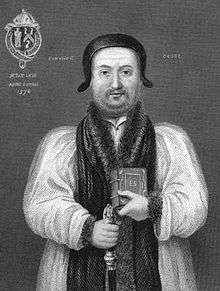 Edmund Gheast Edmund Gheast |
Translated from Rochester. Also Lord High Almoner. Died in office. |
| 1577 | 1589 |  John Piers John Piers |
Translated from Rochester. Also Lord High Almoner. Afterwards translated to York |
| 1589 | 1591 | See vacant | |
| 1591 | 1596 | |
Formerly Dean of Rochester. Died in office. |
| 1596 | 1598 | See vacant | |
| 1598 | 1615 | |
Formerly a Prebendary of Winchester. Died in office. |
| 1615 | 1618 | 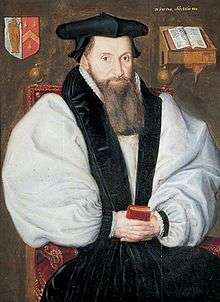 Robert Abbot Robert Abbot |
Formerly Master of Balliol College, Oxford. Died in office. |
| 1618 | 1620 | 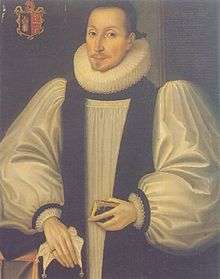 Martin Fotherby Martin Fotherby |
Formerly a Prebendary of Canterbury. Died in office. |
| 1620 | 1621 | |
Also recorded as Robert Townson, Toulson, or Thompson. Formerly Dean of Westminster. Died in office. |
| 1621 | 1641 | 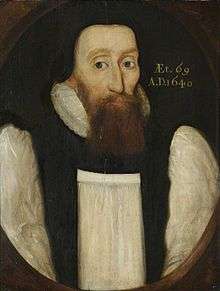 John Davenant John Davenant |
Formerly President of Queens' College, Cambridge. Died in office. |
| 1641 | 1646 |  Brian Duppa Brian Duppa |
Translated from Chichester. Deprived of the see when the episcopacy was abolished by Parliament. |
| 1646 | 1660 | See abolished during the Commonwealth and the Protectorate.[19][20] | |
| 1660 |  Brian Duppa (restored) Brian Duppa (restored) |
Reinstated on the restoration of the episcopacy. Afterwards translated to Winchester. | |
| 1660 | 1663 | 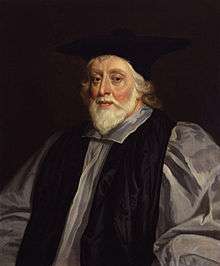 Humphrey Henchman Humphrey Henchman |
Formerly Precentor of Salisbury. Translated to London. |
| 1663 | 1665 |  John Earle John Earle |
Translated from Worcester. Died in office. |
| 1665 | 1667 | |
Formerly Dean of Winchester. Died in office. |
| 1667 | 1689 | 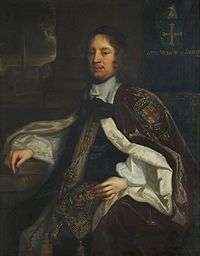 Seth Ward Seth Ward |
Translated from Exeter. Died in office. |
| 1689 | 1715 |  Gilbert Burnet Gilbert Burnet |
Formerly Preacher at the Rolls Chapel. Died in office. |
| 1715 | 1721 |  William Talbot William Talbot |
Translated from Oxford. Afterwards translated to Durham. |
| 1721 | 1723 |  Richard Willis Richard Willis |
Translated from Gloucester. Afterwards translated to Winchester. |
| 1723 | 1734 | 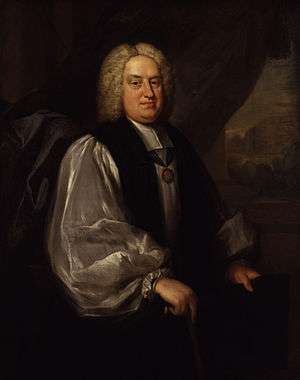 Benjamin Hoadly Benjamin Hoadly |
Translated from Hereford. Afterwards translated to Winchester. |
| 1734 | 1748 | 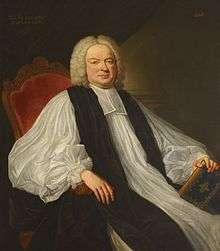 Thomas Sherlock Thomas Sherlock |
Translated from Bangor. Afterwards translated to London. |
| 1748 | 1757 |  John Gilbert John Gilbert |
Translated from Llandaff. Afterwards translated to York. |
| 1757 | 1761 |  John Thomas (I.) John Thomas (I.) |
Translated from Peterborough. Afterwards translated to Winchester |
| 1761 | 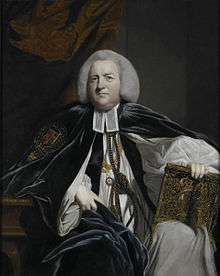 Robert Hay Drummond Robert Hay Drummond |
Translated from St Asaph. Afterwards translated to York. | |
| 1761 | 1766 | |
Translated from Lincoln. Died in office. |
| 1766 | 1782 |  John Hume John Hume |
Translated from Oxford. Died in office. |
| 1782 | 1791 |  Shute Barrington Shute Barrington |
Translated from Llandaff. Afterwards translated to Durham. |
| 1791 | 1807 |  John Douglas John Douglas |
Translated from Carlisle. Died in office |
| 1807 | 1825 |  John Fisher John Fisher |
Translated from Exeter. Died in office. |
| 1825 | 1837 | 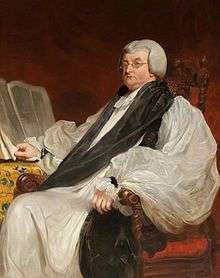 Thomas Burgess Thomas Burgess |
Translated from St David's. Died in office. |
| 1837 | 1854 | 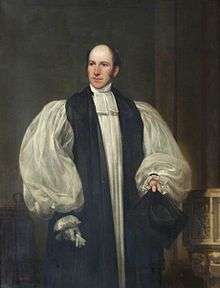 Edward Denison Edward Denison |
Fellow of Merton College, Oxford. Died in office. |
| 1854 | 1869 |  Walter Hamilton Walter Hamilton |
Formerly a Canon-resident and Precentor of Salisbury. Died in office. |
| 1869 | 1885 | 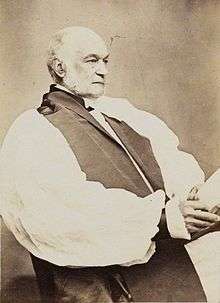 George Moberly George Moberly |
Formerly a Canon of Chester. Died in office. |
| 1885 | 1911 | 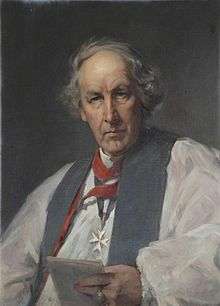 John Wordsworth John Wordsworth |
Oriel Professor of Divinity, Oxford. Founder of Bishop Wordsworth's School. Died in office. |
| 1911 | 1921 |  Frederick Ridgeway Frederick Ridgeway |
Translated from Kensington. Died in office. |
| 1921 | 1935 |  St Clair Donaldson St Clair Donaldson |
Translated from Brisbane. Died in office. |
| 1936 | 1946 | |
Translated from Portsmouth. Retired. |
| 1946 | 1948 | |
Translated from Ripon. Died in office. |
| 1949 | 1962 | |
Translated from Portsmouth. Retired. |
| 1963 | 1972 | |
Died in office. |
| 1973 | 1981 | |
Translated from Guildford. Retired. |
| 1982 | 1993 | |
Retired. |
| 1993 | 2010 | |
Retired. |
| 2011 | incumbent | 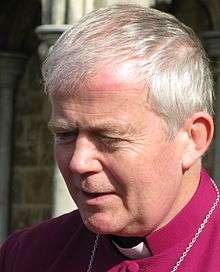 Nicholas Holtam Nicholas Holtam |
Nominated on 12 April,[1][2] consecrated on 22 July,[3] and installed on 15 October 2011.[4] |
| Source(s):[12][17][21] | |||
References
- 1 2 "Diocese of Salisbury". Number10.gov.uk. 12 April 2011. Retrieved 20 June 2016.
- 1 2 "New Bishop of Salisbury Announced — Diocese of Salisbury". Diocese of Salisbury. 23 April 2012. Retrieved 20 June 2016.
- 1 2 "Bishop Nicholas Consecrated". Diocese of Salisbury. 23 April 2012. Retrieved 20 June 2016.
- 1 2 "Bishop's Enthronement Has Children at Heart". Diocese of Salisbury. 23 April 2012. Retrieved 20 June 2016.
- 1 2 3 The Diocese of Salisbury. "The History of the Diocese". Church of England (Salisbury), 2015. Accessed 3 Jan 2015.
- ↑ Dolan, John Gilbert. "Malmesbury" in the Catholic Encyclopedia, Vol. IX. Encyclopedia Press (New York), 1913.
- ↑ Palmer, J.J.N. & al. "Place: Salisbury" at Open Domesday.
- ↑ British History Online. Fasti Ecclesiae Anglicanae 1066–1300, Vol. IV, "Salisbury: Bishops". Institute of Historical Research (London), 1991.
- ↑ Easton, James. A Chronology of Remarkable Events Relative to the City of New Sarum, with the Year, and the Name of the Mayor in whose Time they occurred: Chiefly collected from the authentic Sources of the City Records, and Manuscripts of Citizens, From A.D. 1227 to 1823, a Period of 596 Years, Including the Prices of Wheat and Barley from an Early Æra: To which are added, Their annual Average Prices for 28 Years, Being from 1796 to 1823, 5th ed., p. 1. J. Easton (Salisbury), 1824.
- ↑ Crittall, Elizabeth (ed.). "Victoria County History - Wiltshire - Vol 6 pp93-94 - Salisbury: The word 'Sarum'". British History Online. University of London. Retrieved 20 June 2016.
- ↑ Salisbury Diocesan Synod minutes – 99th session, 7 November 2009 p. 3 (Accessed 23 April 2014)
- 1 2 3 4 "Historical successions: Salisbury (including precursor offices)". Crockford's Clerical Directory. Retrieved 3 August 2012.
- ↑ Fryde, E. B.; Greenway, D. E.; Porter, S.; Roy, I., eds. (1986). Handbook of British Chronology (3rd, reprinted 2003 ed.). Cambridge: Cambridge University Press. p. 222. ISBN 0-521-56350-X.
- ↑ Fryde et al. 1986, Handbook of British Chronology, pp. 270–271.
- ↑ Greenway, D. E. (1991). "Bishops of Salisbury". Fasti Ecclesiae Anglicanae 1066–1300: Volume 4: Salisbury. British History Online. pp. 1–7.
- 1 2 Horn, J. M. (1962). "Bishops of Salisbury". Fasti Ecclesiae Anglicanae 1300–1541: Volume 3: Salisbury Diocese. British History Online. pp. 1–3.
- 1 2 3 Horn, J. M. (1986). "Bishops of Salisbury". Fasti Ecclesiae Anglicanae 1541–1857: Volume 6: Salisbury Diocese. British History Online. pp. 1–5.
- ↑ Fryde et al. 1986, Handbook of British Chronology, p. 271.
- ↑ Episcopy. British Civil Wars, Commonwealth and Protectorate 1638–60. Retrieved on 20 August 2011.
- ↑ King, Peter (July 1968). "The Episcopate during the Civil Wars, 1642–1649". The English Historical Review. Oxford University Press. 83 (328): 523–537. doi:10.1093/ehr/lxxxiii.cccxxviii.523. Retrieved 20 August 2011.
- ↑ Fryde et al. 1986, Handbook of British Chronology, pp. 271–272.
Bibliography
- Fryde, E. B.; Greenway, D. E.; Porter, S.; Roy, I., eds. (1986). Handbook of British Chronology (3rd, reprinted 2003 ed.). Cambridge: Cambridge University Press. ISBN 0-521-56350-X.